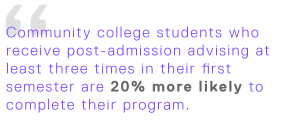
When I think about the pressures my colleagues in the Community College space are facing, my head starts to spin. The largest sector in higher education is composed of community colleges that serve undergraduate student populations. In fact, according to the College Board approximately 42% of all undergraduate students, many with part-time status, attend a community college.
As if the charge of providing access to undergraduate education in America was not enough, community colleges have recently been tasked with more emergent outcomes such as credentialing, workforce development, and elective enrichment programs. (Unfortunately, my travel schedule continues to ruin my plans of finally enrolling in extension courses on Tarot Reading.) This plurality of mission, combined with a diverse student body, presents unique challenges for community colleges that, to me, feel pretty overwhelming.
Current Federal Budget Negotiations
As open-access institutions, community colleges have historically served an important role in providing post-secondary education to undocumented students. As such, they are disproportionately affected by the recent changes to DACA programs. This week, it’s expected that Democratic leaders will continue to seek a solution for Dreamers affected by changes to DACA under the new administration, in exchange for votes to approve federal budgets and avoid government shutdown. Dreamers, themselves, are pursuing similar advocacy efforts this week.
Meanwhile, undocumented students’ wellbeing hangs in the balance. In addition to focusing on academic success at their current institutions, many undocumented students are concerned about deportation to countries of origin they, quite frankly, don’t remember living in. More specifically, LGBTQ+ Dreamers are advocating for a solution because they fear their orientation could make them vulnerable to immigration enforcement in countries outside of the United States, where attitudes towards them are less inclusive, violent, or even hostile.
The Latest on the Prosper Act
Also announced this week was the Prosper Act, a proposed reform of the 1965 Higher Education Act- originally designed to strengthen access to federal financial aid for colleges and universities. The new bill proposes significant changes that affect higher education as a whole, and has been received with not-so-mixed reviews from professionals in our industry. For community colleges specifically, the bill’s main theme of tying higher education funding to performance outcomes is problematic for a couple of reasons.
First, the mission of community colleges is plural, and they serve incredibly diverse populations of students with different degree goals or even non-degree goals, (remember my Tarot reading aspirations?). This alone creates problems when tying federal aid, which serves the neediest students, to narrow outcomes like transfer out and completion rates. If anything, community colleges need more resources, not fewer, to enhance students’ progress towards transferring out and completing degree programs.
Second, one of the metrics involved with receiving federal funding is a school’s loan default rate. This is especially challenging for community colleges. Due to their mission of access and affordability, community colleges have a much lower percentage of students who borrow money than other institutions. Many students are able to pay their tuition due to lower costs, Pell grants, and other federal or state sources of aid. However, the loan default rates that determine funding are calculated based on the total number of borrowers for an institution who default, without considering those who didn’t need to borrow in the first place. This metric could penalize community colleges, whose loan default rates are inflated compared to other institutional segments of higher education.
Ahead of the Curve: Guided Pathways Programs
Thankfully, our community college colleagues are ahead of the curve. They’ve been working on improving outcomes long before changes in the current administration began to materialize. One avenue in which community colleges have begun to define student success is through guided pathway programs that detail plans of study and accelerate attainment for community college students.
This past week, full implementation of the Pathways Project was forecasted to materialize in one year. This indicates a cultural shift within community colleges that has historically placed the responsibility of success on the student, to one that is guided and owned by the institution.
Nonetheless, questions remain about how to identify and reach all students entering community colleges. This especially holds true for students that require supplemental instruction or coursework, and students that haven’t been prepared by their previous experiences for a prescriptive plan. Not only do we need the plans themselves, but also the proper tools that aid in tracking students’ engagement and progress towards their goals to help them succeed.
To me, these seemingly disparate current issues have far-reaching implications and there’s work that must be done both on campuses across the country and at the Capitol. More than ever, we have to think about how to put our students — especially those who have not been characterized as “traditional” — first.
Three Ways to Put Your Students First This Week
1. Call and write your state representatives.
I don’t love the idea of shutting down the government or using students’ lives as a bargaining chip in a political process. But the economic and human impact facing our most vulnerable students in addition to the institutions that serve them is far too important to ignore. I’ll definitely be writing and calling my State Senators and Representatives this week.
2. Anticipate your students’ needs and concerns with proactive communications.
We know that when students are in crisis or simply feeling stressed, they often don’t know how or who to ask for help. Students need a prescriptive, but caring, approach during crucial transition times — Vincent Tinto, acclaimed higher education theorist, reported that community college students who receive post-admission advising at least three times in their first semester are 20% more likely to complete their program. Most campuses have a ton of resources, from psychological, financial, and legal counseling to caring professors, tutoring services, and advising centers that can help students stay on track in trying times. But, many institutions fail to connect students to such resources in a proactive manner.

Invite students to schedule an appointment. Ask them to coffee. Connect them with a colleague who has expertise in what they’re going through. Although I’m no longer working on campus in a direct sense, I’m involved in campus life through volunteerism and my work at TargetX. I’ll be reaching out to colleagues in my network that work with students impacted by DACA and letting them know they’re not alone.
3. Gather best practice feedback from your neighboring institutions and colleagues.
As you seek to reach students with critical updates, whether it be about financial aid, immigration, or pathways to success, sharing best practices about what’s working for your school is vital. Today, there’s so much rhetoric focused on what isn’t working for student success — let’s empower one another to change the conversation. Call your neighboring institutions and colleagues to hear some inspirational stories about student success initiatives that may also be a fit for your campus.
Not sure who to call? I’d love to share what our Community College partners at TargetX are doing to make a positive impact on student success by putting their students first.


